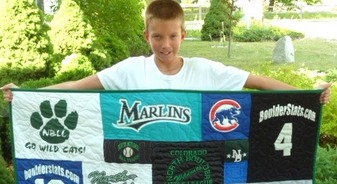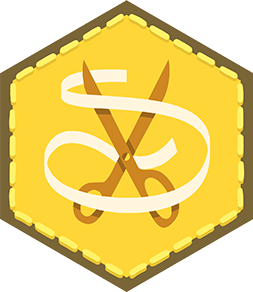Make a quilt
Make a simple patchwork quilt by cutting fabric squares, arranging patterns, sewing or tying pieces together, and learning measuring and basic sewing skills.



Step-by-step guide to make a simple patchwork quilt
Your First Quilt - Beginner Tutorial, Part 1
Step 1
Gather about 15 to 25 fabric scraps and put them on your work table so you can see all the colors and patterns.
Step 2
Choose a finished square size for your quilt pieces such as 6 inches.
Step 3
Use the ruler and fabric marker to draw square outlines on the fabrics adding 1/2 inch around each square for seam allowance.
Step 4
Cut out the marked squares carefully with fabric scissors.
Step 5
Lay the cut squares on the floor or table and move them until you like the color pattern and layout.
Step 6
Pick the first two squares and place them right sides together.
Step 7
Pin the two squares together along one edge using pins or clips.
Step 8
Sew the pinned edge with a 1/2 inch seam allowance using a sewing machine or hand stitch with a needle and thread.
Step 9
Repeat pinning and sewing to add more squares until you complete one full row.
Step 10
Make several matching rows by repeating Steps 6 to 9 until your quilt top reaches the size you want.
Step 11
Pin two finished rows together aligning the seams and sew along the long edge to join them.
Step 12
Lay the quilt top on the batting and then on the backing fabric and pin or baste the three layers together.
Step 13
Quilt the layers by sewing straight lines across the quilt every few inches or by tying knots through all layers to hold them.
Step 14
Trim the edges so all layers are even and sew a folded fabric strip around the edges to make a simple binding.
Step 15
Take photos of your finished quilt and share your creation on DIY.org
Final steps
You're almost there! Complete all the steps, bring your creation to life, post it, and conquer the challenge!


Help!?
What can we use if we can't find quilting batting or a sewing machine for this quilt project?
If quilting batting is hard to find you can use folded flannel or a thin old blanket as the batting in Step 11, and if you don't have a sewing machine you can hand-stitch the seams in Steps 7–9 with strong thread and small backstitches.
My rows don't line up when I pin two finished rows together—how do I fix that?
If rows don't align when you pin and sew in Step 10, press each seam flat with an iron, confirm every seam was sewn with the 1/2-inch allowance from Step 7, and then resew or trim any seam allowances that are inconsistent before joining the rows.
How can we adapt the activity for younger children or older kids?
For ages 3–6 let children sort scraps and lay out patterns in Steps 1 and 5 while an adult does the cutting and sewing in Steps 3–9, and for ages 10+ let kids measure, cut, pin, sew rows, and baste the quilt layers themselves with supervision.
What are simple ways to personalize or upgrade the finished quilt?
Enhance the quilt by embroidering names or motifs onto selected squares after cutting in Step 4, quilting decorative lines or shapes across the layers in Step 12, and choosing a contrasting binding fabric in Step 14 before taking photos in Step 15.
Watch videos on how to make a simple patchwork quilt
Ultimate Beginners guide to making a Quilt | Step by step tutorial
Facts about quilting and basic sewing for kids
✂️ Beginner patchwork quilts often use 4–6 inch fabric squares — a perfect size for cutting, arranging, and sewing for kids.
📏 Quilters usually sew a 1/4-inch seam allowance — little measuring habits make a big difference in how pieces fit together!
🎨 Quilting bees were social events where neighbors gathered to sew, share snacks, and help finish big quilts together.
🧵 Quilts have been made for hundreds of years and were often used to tell family stories or mark special events.
🪡 You can make a warm quilt without a machine by tying the layers together — a fun, no-sew option for children.
How do I make a simple patchwork quilt with my child?
What materials do I need to make a child-friendly patchwork quilt?
What ages is making a patchwork quilt suitable for?
What are the benefits of making a patchwork quilt with kids?


One subscription, many ways to play and learn.
Only $6.99 after trial. No credit card required



